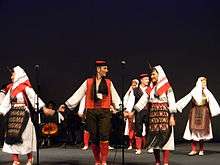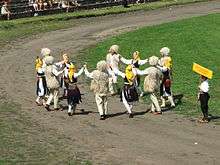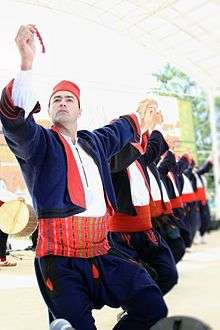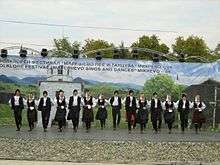Serbian dances
| Part of a series on the |
| Culture of Serbia |
|---|
 |
| People |
| Cuisine |
| Festivals |
|
|
|
Music and performing arts
|
| Sport |
|
Organisations |
|
Dancing tradition in Serbia is represented by various styles of dances in the country. As with other aspects of Serbian culture, different forms of dances originated in different parts of Serbia, developed according to the local traditions and also acquired elements from other parts of the country.
Serbian folk dancing, kolo ("circle [dance]"), includes many varieties. The most popular dances are Užičko kolo,[1] and Moravac,[2] while other popular dances include Kokonješte, Žikino kolo and Vranjanka.[2]
Dances
- Užičko kolo (from Užice)
- Moravac (from Great Morava)
- Kokonješte
- Žikino kolo
- Vranjanka (from Vranje)
- Bojarka (Serbian Noble Dance)
- Oro (Serbian Eagle Dance from Montenegro and Herzegovina)
- Čačak

 Dance from Gnjilane, Ensemble Kolo
Dance from Gnjilane, Ensemble Kolo Dance from Glamoč, Ensemble Kolo
Dance from Glamoč, Ensemble Kolo- Dance from Pirot
 Dance from Timočka Krajina
Dance from Timočka Krajina Dance from Vranje
Dance from Vranje Dance from Leskovac
Dance from Leskovac
See also
| Wikimedia Commons has media related to Serbian folklore. |
References
- ↑ Ursula Hemetek; Adelaida Reyes; Institut für Volksmusikforschung und Ethnomusikologie--Wien (2007). Cultural diversity in the urban area: explorations in urban ethnomusicology. Institut für Volksmusikforschung und Ethnomusikologie. ISBN 978-3-902153-03-6.
They played newly composed folk music as well as kolos such as Uzicko kolo, a very popular dance melody from Serbia. The dance, one of the musical ethnic symbols of Serbia; might allude to Serbian ethnicity; otherwise we did not find any ...
- 1 2 Savez udruženja folklorista Jugoslavije. Kongres (1965). Rad ... Kongresa Saveza folklorista Jugoslavije. Savez folklorista Jugoslavie.
Za poslednjih dvadesetak godina Moravac je potisnuo svoje prethodnike Kokonjeste, 2ikino kolo i Vranjanku (brzu), naravno, ne potpuno, ali ipak toliko efikasno da je zauzeo mesto pored njih, pa i ispred njih.
Sources
- Vladimir Mutavdžić (2005). Narodni plesovi Srbije: praktikum pedagoške prakse. Studentski kulturni centar. ISBN 978-86-7757-115-3.
- Desa Đorđević (1988). Narodne igre Šumadije i Pomoravlja. Kulturno-prosvjetni sabor. ISBN 978-86-80825-62-5.
- Ljubica S. Janković; Danica S. Janković (1951). Narodne igre. Štamparija D. Gregorića.
- Tihomir R. Đorđević (1907). Srpske narodne igre. 9–10. Srpska kraljevska akademija.
- Bogdanka Đurić; Radomir Janković; Vasilije Pavlović (1991). Srpske narodne igre. Prosveta-Koprodukcija.
- Dragoslav Džadžević (2006). Narodne igre severoistočne Srbije. Kulturno-prosvetna zajednica.
- Margarita Debeljak; Milica Ilijin (1953). Mađarske narodne igre iz Vojvodine. Bratstvo Jedinstvo.
- Branka Koturović; Aleksandar Marinković (1973). Narodne igre Jugoslavije: metodika, tehnika, ritam. Interplas.
- Vladimir Kirin (1965) [1954]. Narodni plesovi Jugoslavije. Naklada Color.
This article is issued from
Wikipedia.
The text is licensed under Creative Commons - Attribution - Sharealike.
Additional terms may apply for the media files.